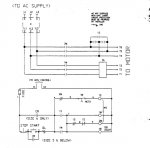Russs57
Senior Member
- Location
- Miami, Florida, USA
- Occupation
- Maintenance Engineer
I was asked to look at a 3 phase, 208 VAC, elevator motor-generator that is single phasing after transitioning to delta. Elevator company is blaming it on our wiring to fusible disconnect. Haven’t had a chance to check much but this is where I’m at. Sorry but I don’t have nameplate data on HP or anything.
Motor-generator starts and runs fine in wye. Inrush current is short duration so I couldn’t measure all phases at same time. Still I fired it up a couple of times and measured good current draw in the 150 amp range on different phases. Current quickly falls to around 12 amps per leg, is balanced, and motor runs fine with no abnormal vibration or sounds.
In about 4 to 5 seconds it transitions to delta and draws roughly 63, 0, 63 amps. One contact on the delta run starter gets very hot very fast.
So question one. Is that enough info to say it isn’t on building side? I suspect a contact on delta/run starter. Reckon I should mention this is late 1940’s vintage stuff and doesn’t look like anything you would see today. Nothing is marked. Can’t tell line from load and what wires are T4, T5, and T6. T1, T2, and T3 are direct to line with no starter contacts. Did reverse A and B phase at disconnect to see if problem followed phase but unit wouldn’t go into Delta then.
Question two. I looked at original schematic and I think it is wrong. They show T1 going to L1 as expected. But they show T4 going to L3. T2 goes to L2 as expected. But they show T5 going to L1. They show T3 going to L3 as expected. But T6 goes to L2.
That would give same rotation in wye and delta but I’m thinking (and admitting I don’t know) that phasing isn’t right and would call for big slippage in motor and huge current draw at transition from wye to delta. Am I thinking correctly? If so what would you expect symptoms to be and what measurement would you perform to prove wiring on their end is the issue?
Motor-generator starts and runs fine in wye. Inrush current is short duration so I couldn’t measure all phases at same time. Still I fired it up a couple of times and measured good current draw in the 150 amp range on different phases. Current quickly falls to around 12 amps per leg, is balanced, and motor runs fine with no abnormal vibration or sounds.
In about 4 to 5 seconds it transitions to delta and draws roughly 63, 0, 63 amps. One contact on the delta run starter gets very hot very fast.
So question one. Is that enough info to say it isn’t on building side? I suspect a contact on delta/run starter. Reckon I should mention this is late 1940’s vintage stuff and doesn’t look like anything you would see today. Nothing is marked. Can’t tell line from load and what wires are T4, T5, and T6. T1, T2, and T3 are direct to line with no starter contacts. Did reverse A and B phase at disconnect to see if problem followed phase but unit wouldn’t go into Delta then.
Question two. I looked at original schematic and I think it is wrong. They show T1 going to L1 as expected. But they show T4 going to L3. T2 goes to L2 as expected. But they show T5 going to L1. They show T3 going to L3 as expected. But T6 goes to L2.
That would give same rotation in wye and delta but I’m thinking (and admitting I don’t know) that phasing isn’t right and would call for big slippage in motor and huge current draw at transition from wye to delta. Am I thinking correctly? If so what would you expect symptoms to be and what measurement would you perform to prove wiring on their end is the issue?

